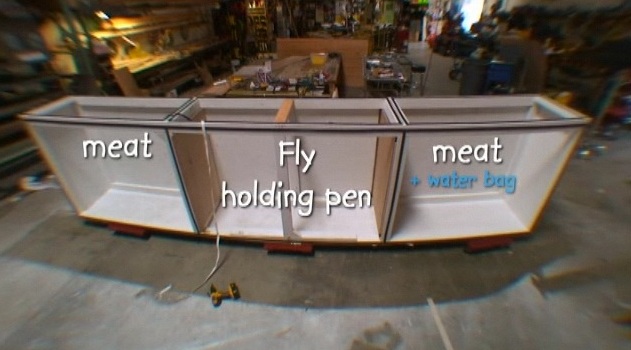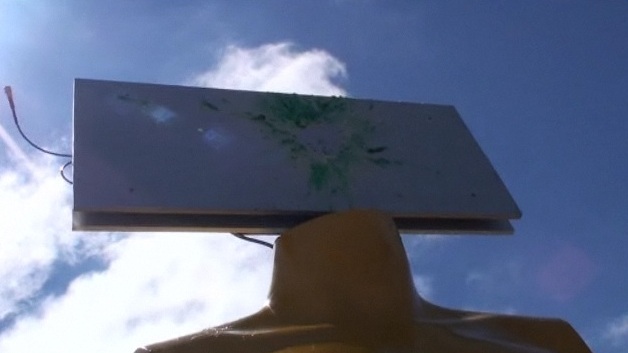
Episode: MythBusters 8.26 – “Bug Special”
Original Air Date: December 1, 2010
One thing the MythBusters are known for (besides blowing things up) is collecting myths that are somehow related to each other and presenting them in a theme show, which is what they did in this episode, the “Bug Special.” Honeybees, house flies, even huge African beetles — all were represented in this installment of MythBusters that was all about bugs and the amazing and sometimes deadly things that they are purported to do. To make it even more special, they found three myths to bust, including a viral video and one by popular demand via the fan website. Can honeybees really lift a laptop? Does plain old water really repel flies? Can a bug strike really kill a motorcyclist? Keep reading for a rundown of each set of experiments and their results (unless, of course, you don’t want to be spoiled).
Myth #1: If you attract about a thousand bees to a laptop covered in glue, the bees that stick to the glue will together be able to lift the laptop off of a surface and support its weight in the air, as shown in a viral video making its way around the Internet.
MythBusters: Adam and Jamie
Procedure 1:
- Gather a laptop, short-acting bee-safe glue, honey, and one frame of bees from a bee hive, as shown in the video.
- Spread the glue on the back of the laptop, which has been opened to the point where it is flat. Drizzle honey over the glue to attract the bees.
- Take one frame of bees from a beehive and shake over the glue-covered laptop so that as many bees as possible stick to the glue. Repeat with another frame of bees for better bee coverage.
- Observe the laptop for signs of movement due to the bees on it.
Results: The laptop didn’t move.

Procedure 2:
- Mix the glue and honey together, then spread it onto the laptop again. Place a container holding a queen bee in the middle of the laptop to attract as many bees as possible to it.
- Shake three frames’ worth of bees over the laptop.
- Observe the laptop for signs of movement.
Results: The laptop still didn’t move.
Conclusion: Since all the components of the test (glue, honey, bees, etc.) worked like they were supposed to, as seen in the video, the fact that the laptop didn’t budge means that the myth is busted and the video is faked. To confirm this assessment, further tests can be done to explain why the myth is busted.
Procedure 3:
- Determine one bee’s lifting capacity by tying a series of beads to a length of thread at equal intervals then tie the thread around the middle of a bee. Count how many of the beads the bee is able to lift off of the ground while flying. Weigh that number of beads to determine the amount of weight lifted. Determine the weight of the laptop and calculate how many bees would be needed to lift it, based on the lifting capacity of one bee. Determine how many bees fit in one square inch, then measure the area of the laptop to determine how many bees would be able to fit on the laptop.
- Demonstrate the physical principles of lifting the laptop by attaching a number of small remotely controlled toy helicopters to a lightweight wooden frame. Observe to see if the helicopters can lift it off of the ground. Cover the frame with a sheet of plastic and observe again to see if the helicopters can lift it.
Results: The bee lifted 8 beads, weighing a total of 96 milligrams, the weight of the laptop is 2216 grams, and about ten bees fit in one square inch. The toy helicopters were able to lift the wooden frame by itself, but when it was covered in plastic, they were not able to lift it.
Conclusion: Definitely busted. Based on bee lifting capacity, about 23,000 bees would be needed to lift the laptop, ten times more bees than would actually fit on the laptop. Even if that many bees would fit, they still wouldn’t be able to lift the laptop. As demonstrated in the two tests with the toy helicopters, when bees are flying their wings create lift while forcing air downwards. If they are glued to the laptop, the force of the air pushing down on the laptop is greater than the force of lift in the opposite direction, preventing the bees from flying. If Adam and Jamie had studied the physical principles at work and performed these tests first, there would have been no need to expose Adam to his insect nemesis because they would have known that what appeared to be happening in the video could not happen. However, that would not have been the MythBusters way! After busting the myth, they went on to demonstrate how they think the video was made: by attaching monofilament (which is virtually invisible) to the laptop and suspending it from a wooden beam out of camera range, Adam and Jamie could raise and lower the laptop in an almost identical manner to the movement observed on the video.

Myth #2: Hanging up a clear plastic bag of water will repel flies from an area.
MythBusters: Kari, Grant, and Tory
Procedure:
- Build a box with three compartments separated by removable panels. Fill the middle section with about 5,000 maggots and wait for them to grow into houseflies.
- Obtain some rotten meat and put equal amounts of it in each of the end compartments of the box. Fill a clear plastic bag with water and hang it in one end with the meat.
- Place the box outside in the sun. Remove the wooden panels separating the compartments and allow the flies access to the meat on either end for one hour.
- At the end of one hour, replace the panels, trapping the flies in one of the three compartments.
- Wait until all the flies have died, then remove them from the box. Compare the number in the compartment containing both the meat and the bag of water to the number in the compartment containing only meat.
Results: The total weight of the flies in the side with only meat was 20 grams. The total weight of the flies in the side with the bag of water was 35 grams.
Conclusion: Myth busted. Since there were more flies by weight in the side with the bag of water, the water evidently did not refract the sunlight in such a way as to confuse the flies’ prismatic eyes and repel them from the meat in that compartment.
Myth #3: Someone riding a motorcycle can be killed if struck by an insect (not because the insect distracted the rider and caused him or her to crash the motorcycle, but from the force of the impact).
MythBusters: Kari, Grant, and Tory
Procedure 1:
- Talk to a trauma specialist and learn how much force is required to cause a fatal injury. From this information, determine the most likely vulnerable spot that the insect could hit.
- Replace the head of a mannequin with a force plate and place the mannequin in a motorcycle sidecar.
- Suspend a fly from a frame in the motorcycle’s path. Drive the motorcycle so that the fly strikes the force plate while the motorcycle is going 85 mph.
- Record the amount of force exerted upon the force plate by the fly.
- Replace the fly with a cicada and repeat steps three and four.
- Replace the cicada with a Goliath beetle (one of the largest insects in the world) and repeat steps three and four.
Results: The fly struck with 10 pounds of pressure on the force plate. The cicada struck with 37 pounds of pressure. The Goliath beetle struck with 100 pounds of pressure.

Conclusion: According to the trauma specialist, the throat is the most vulnerable place for the bug to hit because it takes only about 76 pounds of pressure to fracture the windpipe and cause the victim to suffocate, compared to 400-4000 pounds, depending on the person’s size, for a strike to the chest to cause death and 2000 pounds for a strike to the head. Based on that, it is plausible for a motorcycle rider to be killed if struck in the throat by one of the largest insects on earth while going 85 mph. Seeing as how Goliath beetles are only found in Africa and the throat is a small and relatively sheltered target, however, this scenario is highly unlikely. But, just to make sure, some further tests are needed to take into account the possibility of higher speeds and insects striking other areas of the body.
Procedure 2:
- Place a Goliath beetle in a foam sabot and insert it into an air cannon. Aim the air cannon at the force plate and fire it with enough pressure to simulate the force of a bug hitting a rider who is going 120 mph. Record the amount of force with which the insect hits the force plate.
- Increase the pressure to simulate a strike at 200 mph (the highest speed for which a motorcycle rider has ever been issued a speeding ticket) and repeat step 1.
Results: At 120 mph, the bug strikes with 280 lbs. of force. At 200 mph, it strikes with 558 lbs. of force.
Conclusion: A very large bug hitting a small person in the chest while going very, very fast on a motorcycle could kill that person. However, while technically plausible, this myth remains very, very unlikely.
Episode Conclusions: When you tell me an episode is a “Bug Special,” then I expect to see spectacular things being done to spectacular insects and/or other creepy crawlies. It needs to live up to the expectations set by previous specials. I mean, who can forget the “Pirate Special” where they negotiated obstacle courses in the dark and shot cannon balls at dead pigs? Or the “Snow Special” where they tried to cause an avalanche by yodeling? Or the “Shark Specials” where they risked life and limb to match wits with one of the scariest creatures in the ocean? To me, “Bug Special” should be equally as exciting — where were the killer bees, or the South American ants carrying Buster away? It wasn’t a bad episode at all, and it had many quintessential MythBusters elements, among them high speeds, outlandish myths, shooting things, and taking the experiments out to the farthest degree possible even after the myth is busted. It just didn’t live up to its name as a “special.”
Rating: 3 / 5 Stars






